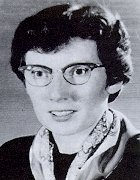| 1 | 2 | 3 | 4 | 5 | 6 | 7 | 8 | 9 | 10 | 11 |
Chapter 10: Buildings and Books
The Library
Developing an adequate law library at the early University of British Columbia was an enormous task. Little funding was available from the government of British Columbia’s start-up grant after other essential expenses were covered. A law library was desperately needed and had to be built from scratch. Few law faculties in Canada at the time had resources beyond the bare, minimal, working library. Professional law librarians were unheard of until University of British Columbia law graduate Diana Priestly assumed faculty duties in that capacity in the 1950s. When the library was first developed, Professor Gilbert Kennedy ("indefatigable as far as energy for the law school was concerned", according to Diana Priestly) administered it with the aid only of part-time student assistance.

| Professor Diana Priestly. An early University of British Columbia law graduate, Professor Priestly studied library science in the United States before returning to her alma mater to become Canada’s first professional law librarian. |
The dean threw himself actively into the tasks related to acquiring library material from the beginning, determined, he said, to create the sort of "breadth-inducing research" library "on which the advancement of learning in any discipline so largely depends". It was often dirty work but, as they say, someone had to do it. In rebuttal of persistent rumours that he would regularly review newspaper obituaries hoping to find estates with unwanted books available for donation, Dean Curtis told Murray Fraser in 1980 that "It’s a good story. I hate to say it’s not true". Obituary columns and grieving families were out of bounds. But there was little else honourable and legal that the dean did not undertake to build a reputable library. A good library is indispensable to the work of any decent law faculty because, as Lucas, wrote in 1952, "the Law is in the Books. The library is the blood circulation, as it were, in the body of this school." Donations from all sources (including, of course, estates) were of great importance in the early years.
Attics and back lane garbage pick-ups, as well as more conventional sources were scoured in order to build up a world of legal knowledge at the University of British Columbia. Mr. Justice J. E. Clearihue called Dean Curtis on one occasion to report that the attic of an apartment house in Victoria contained a large collection of law books. "[A]rmed with a pair of coveralls," Curtis reports that he travelled to Victoria and "went up into the attic":
There they were, hundreds of books but the pigeons had got through the broken windows with the usual results. So I went out to Woolworth’s and bought myself a scrub brush and removed what I could from the books. But I decided we could use the books so I arranged for them to be picked up . . . several boxes were shipped over.
On another occasion books were literally retrieved from the garbage. Returning to Vancouver from the 1946 Canadian Bar Association meetings in Winnipeg, Curtis dropped in to visit his friend M. A. MacPherson in Regina. MacPherson, who had recently moved into an apartment, revealed that he had left a set of Hansards running from Confederation to 1946 in the back lane for garbage pick-up just a few days earlier. "There was only a half an hour to train time," according to Dean Curtis "but that was enough to solicit the help of Mr. Donald MacPherson, his son (now Chief Justice MacPherson), to retrieve the books the next morning should they still be sitting in the lane. They were still there the next morning, and with a good showing of Regina gumbo on their spines from the week-end rain, sent to us, are duly shelved in the School."
| In 1948 Leon and Walter Koerner anonymously donated $10,000 to establish a law library. This figure exactly matched the amount President Klinck had determined was necessary to create a quality university law library. One suspects that it was the Koerner's intention to provide by one donation a full and complete law library for the University of British Columbia. — Dean George Curtis, 1995 |
Efforts of these sorts paid off rapidly. Within four years the University of British Columbia law library had grown from nothing to 12,000 volumes, making it the largest law collection in Canada apart from the much older collections of McGill and Dalhousie. By the mid-1950s the collection had reached, perhaps, 30,000 volumes.
By November 1951 the new facility was ready to be occupied. The moving job was enormous, however, and the university arranged for the faculty to be closed for a few days while books were moved over. The students would have none of it and organized a work gang to ferry books over to the new building. Madam Justice Southin remembers that the students were organized "like a bucket brigade . . . and you got yours and the person at the end put them up on the shelf". Nobody was paid for the work: "we were just labourers but we didn’t know . . . it was sort of fun".
The move was completed in a single day. To speed things up the students had taken a chain saw to the wall of one of the huts, opening a portal at the nearest point possible to the entrance of the new building. "Enough student veterans were still around," Dean Curtis recalled, "to make resourcefulness and self-reliance the order of the day." Nobody, it seems, objected to the incidental destruction of university property.
Copyright © 1995 The University of British Columbia Faculty of Law. All rights reserved.
Please address questions or comments to Professor W. Wesley Pue, pue@law.ubc.ca